Prediction of Ultra-Short-Term Photovoltaic Power Using BiLSTM–Informer Based on Secondary Decomposition
Abstract
1. Introduction
2. Methods
2.1. Variational Mode Decomposition (VMD)
2.2. Complementary Ensemble Empirical Mode Decomposition with Adaptive Noise (CEEMDAN)
2.3. BiLSTM
2.4. Information Extractor Model
3. Modeling of Ultra-Short-Term PV Power Prediction Based on VMD–CEEMDAN–BiLSTM–Informer
3.1. VMD–CEEMDAN–BiLSTM–Informer Hybrid Model
- (1)
- Primary decomposition: The collected PV data are preprocessed. Firstly, the number of VMD layers is determined by the center frequency, and then the PV data are decomposed to obtain several component sequences and residuals with lower complexity and nonlinearity.
- (2)
- Secondary decomposition: The residual components obtained in the previous step are further decomposed using CEEMDAN to obtain the subsequence imf and the smooth residual term, and all the sequences are used as inputs to the prediction model.
- (3)
- The BiLSTM model, which captures short-term time-dependent and local features in parallel prediction, is used to model the temporal information of the IMF of the VMD, while the Informer model, which can efficiently capture global trends, is used to predict the imf components obtained from the secondary decomposition of the CEEMDAN, and the features of each decomposed signal are extracted.
- (4)
- Finally, the feature output of each decomposed signal is reconstructed and superimposed through the fully connected layer (FC) to obtain the final power prediction result.
3.2. Assessment Indicators
4. Experimental Contents
4.1. Dataset
4.2. PV-Output-Influencing Factors and Clustering
4.3. Secondary Decomposition
4.4. VMD–CEEMDAN–BiLSTM–Informer Power Prediction
5. Conclusions
- (1)
- Key meteorological factors influencing PV power generation were identified through data processing and analysis. The data were then categorized into sunny, cloudy, and rainy days using clustering, enabling the development of weather-specific predictive models.
- (2)
- Employing VMD and CEEMDAN for secondary data decomposition effectively mitigates modal aliasing while preserving the inherent characteristics of the PV sequence. This approach yields multiple intrinsic mode functions (IMFs) with varying temporal scales, thereby capturing the localized dynamics of PV power generation and minimizing the influence of sequence complexity on prediction accuracy.
- (3)
- The proposed BiLSTM–Informer architecture leverages the strengths of both models. BiLSTM effectively models bidirectional error patterns, and Informer’s attention efficiently identifies crucial temporal relationships within the feature set, leading to improved prediction performance.
Author Contributions
Funding
Data Availability Statement
Conflicts of Interest
References
- Duda, J.; Kusa, R.; Pietruszko, S.; Smol, M.; Suder, M.; Teneta, J.; Wójtowicz, T.; Żdanowicz, T. Development of Roadmap for Photovoltaic Solar Technologies and Market in Poland. Energies 2022, 15, 174. [Google Scholar] [CrossRef]
- Yang, X.; Xu, C.; Zhang, Y.; Yao, W.; Wen, J.; Cheng, S. Real-Time Coordinated Scheduling for ADNs with Soft Open Points and Charging Stations. IEEE Trans. Power Syst. 2021, 36, 5486–5499. [Google Scholar] [CrossRef]
- Kundur, P. Sustainable Electric Power Systems in the 21st Century: Requirements, Challenges and the Role of New Technologies. In Proceedings of the IEEE Power Engineering Society General Meeting, Denver, CO, USA, 6–10 June 2004; Volume 2, pp. 2297–2298. [Google Scholar]
- Yang, X.; Zhang, Y.; He, H.; Ren, S.; Weng, G. Real-Time Demand Side Management for a Microgrid Considering Uncertainties. IEEE Trans. Smart Grid 2019, 10, 3401–3414. [Google Scholar] [CrossRef]
- Qin, Y.; Xu, Y.; Wang, X.; Wang, T.; Li, W. Study on Short-Term Photovoltaic Output Prediction Based on Improved FCM-LSTM. Acta Energiae Solaris Sin. 2024, 45, 304. [Google Scholar] [CrossRef]
- Cui, Y.; Sun, Y.C.; Chang, Z.L. A Review of Short-Term Solar Photovoltaic Power Generation Prediction Methods. Resour. Sci. 2013, 35, 1474–1481. [Google Scholar]
- Pretto, S.; Ogliari, E.; Niccolai, A.; Nespoli, A. A New Probabilistic Ensemble Method for an Enhanced Day-Ahead PV Power Forecast. IEEE J. Photovolt. 2022, 12, 581–588. [Google Scholar] [CrossRef]
- Zhao, B.; Wang, Y.; Wang, B.; Xuan, W.; Lei, Z.; Ge, L.; Xv, X. Research on the output power prediction method of distributed photovoltaic systems based on ARIMA time series. Renew. Energy 2019, 37, 820–823. [Google Scholar]
- Hou, W.; Xiao, J.; Niu, L. A prediction method for photovoltaic power generation system output based on grey theory. Electr. Technol. 2016, 53–58. [Google Scholar] [CrossRef]
- Li, Y.; Huang, W.; Lou, K.; Zhang, X.; Wan, Q. Short-Term PV Power Prediction Based on Meteorological Similarity Days and SSA-BiLSTM. Syst. Soft Comput. 2024, 6, 200084. [Google Scholar] [CrossRef]
- Yang, M.; Han, C.; Zhang, W.; Wang, B. A Short-Term Power Prediction Method for Wind Farm Cluster Based on the Fusion of Multi-Source Spatiotemporal Feature Information. Energy 2024, 294, 130770. [Google Scholar] [CrossRef]
- Yang, M.; Huang, Y.; Guo, Y.; Zhang, W.; Wang, B. Ultra-Short-Term Wind Farm Cluster Power Prediction Based on FC-GCN and Trend-Aware Switching Mechanism. Energy 2024, 290, 130238. [Google Scholar] [CrossRef]
- Zhou, H.; Zhang, S.; Peng, J.; Zhang, S.; Li, J.; Xiong, H.; Zhang, W. Informer: Beyond Efficient Transformer for Long Sequence Time-Series Forecasting. Proc. AAAI Conf. Artif. Intell. 2021, 35, 11106–11115. [Google Scholar] [CrossRef]
- Tan, H.; Yang, Q.; Xing, J. Photovoltaic Power Prediction Based on Combined Xgboost-Lstm Model. Acta Energiae Solaris Sin. 2022, 43, 75. [Google Scholar] [CrossRef]
- Jaihuni, M.; Basak, J.K.; Khan, F.; Okyere, F.G.; Sihalath, T.; Bhujel, A.; Park, J.; Lee, D.H.; Kim, H.T. A Novel Recurrent Neural Network Approach in Forecasting Short Term Solar Irradiance. ISA Trans. 2022, 121, 63–74. [Google Scholar] [CrossRef]
- Zhang, Y.; Cheng, Q.; Jiang, W.; Liu, X.; Shen, L.; Chen, Z.H. A photovoltaic power prediction model based on EMD-PCA-LSTM. Acta Energiae Solaris Sinica 2021, 42, 62–69. [Google Scholar]
- Dong, X.; Zhao, H.; Zhao, S.; Lu, D.; Chen, X.; Liu, L. Ultra-short-term photovoltaic power prediction based on SOM clustering and secondary decomposition of BiGRU. Acta Energiae Solaris Sinica 2022, 43, 85–93. [Google Scholar] [CrossRef]
- Sharma, V.; Parey, A. Extraction of Weak Fault Transients Using Variational Mode Decomposition for Fault Diagnosis of Gearbox under Varying Speed. Eng. Fail. Anal. 2020, 107, 104204. [Google Scholar] [CrossRef]
- Dragomiretskiy, K.; Zosso, D. Variational Mode Decomposition. IEEE Trans. Signal Process. 2014, 62, 531–544. [Google Scholar] [CrossRef]
- Hochreiter, S.; Schmidhuber, J. Long Short-Term Memory. Neural Comput. 1997, 9, 1735–1780. [Google Scholar] [CrossRef]
- Shi, Z.; Li, J.; Jiang, Z.; Li, H.; Yu, C.; Mi, X. WGformer: A Weibull-Gaussian Informer Based Model for Wind Speed Prediction. Eng. Appl. Artif. Intell. 2024, 131, 107891. [Google Scholar] [CrossRef]
- Peng, T.; Fu, Y.; Wang, Y.; Xiong, J.; Suo, L.; Nazir, M.S.; Zhang, C. An Intelligent Hybrid Approach for Photovoltaic Power Forecasting Using Enhanced Chaos Game Optimization Algorithm and Locality Sensitive Hashing Based Informer Model. J. Build. Eng. 2023, 78, 107635. [Google Scholar] [CrossRef]
- Cao, Y.; Liu, G.; Luo, D.; Bavirisetti, D.P.; Xiao, G. Multi-Timescale Photovoltaic Power Forecasting Using an Improved Stacking Ensemble Algorithm Based LSTM-Informer Model. Energy 2023, 283, 128669. [Google Scholar] [CrossRef]
- Xu, X.; Guan, L.; Wang, Z.; Yao, R.; Guan, X. A Double-Layer Forecasting Model for PV Power Forecasting Based on GRU-Informer-SVR and Blending Ensemble Learning Framework. Appl. Soft Comput. 2025, 172, 112768. [Google Scholar] [CrossRef]
- Desert Knowledge Australia Centre. 01/01/2017. Download Data. Australia’s iconic Uluru (Ayers Rock). Available online: http://dkasolarcentre.com.au/historical-data/download (accessed on 24 December 2024).
- Mellit, A.; Kalogirou, S.A. Artificial Intelligence Techniques for Photovoltaic Applications: A Review. Prog. Energy Combust. Sci. 2008, 34, 574–632. [Google Scholar] [CrossRef]
- Jiang, Y.; Fu, K.; Huang, W.; Zhang, J.; Li, X.; Liu, S. Ultra-Short-Term PV Power Prediction Based on Informer with Multi-Head Probability Sparse Self-Attentiveness Mechanism. Front. Energy Res. 2023, 11, 1301828. [Google Scholar] [CrossRef]
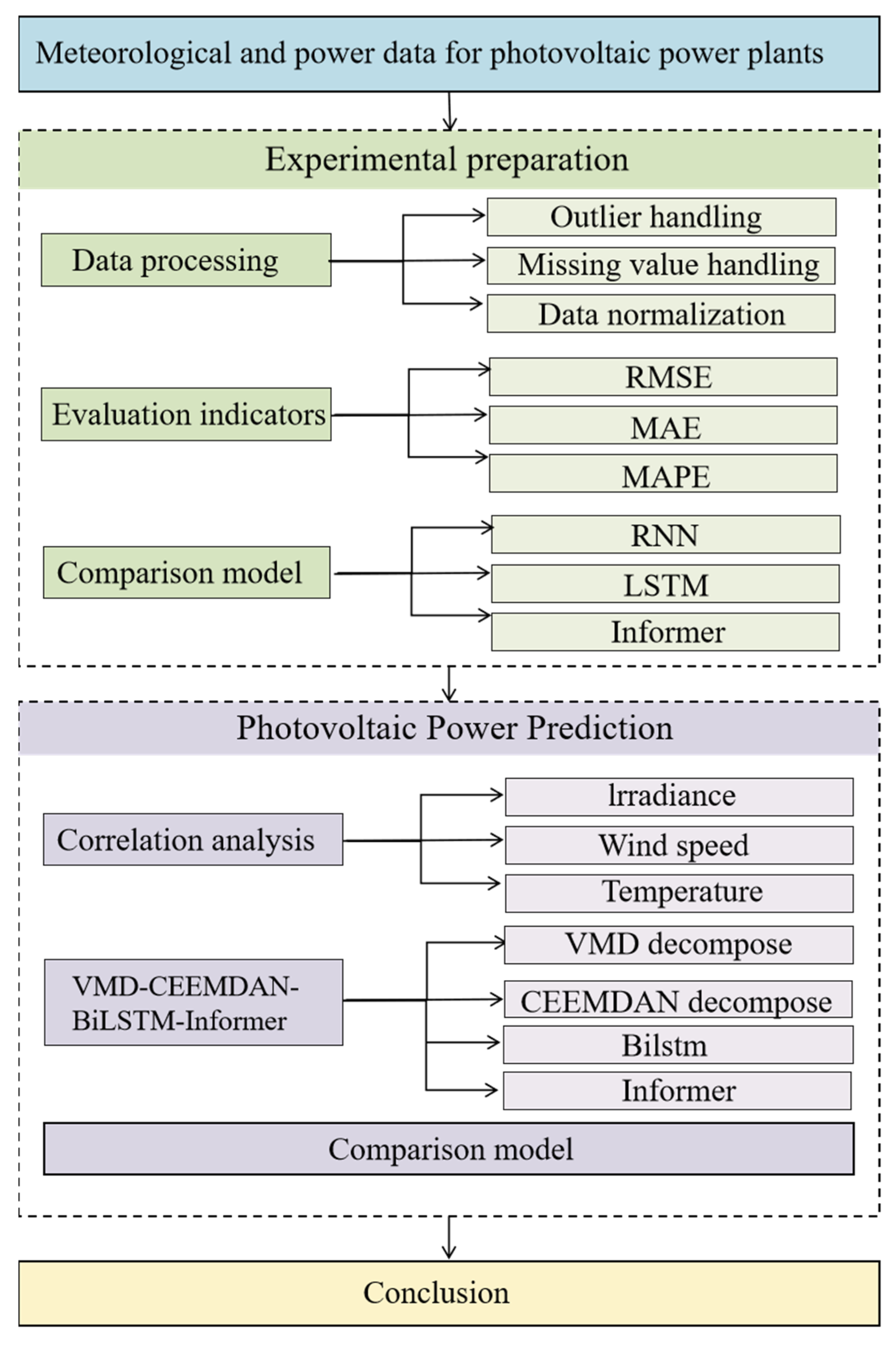
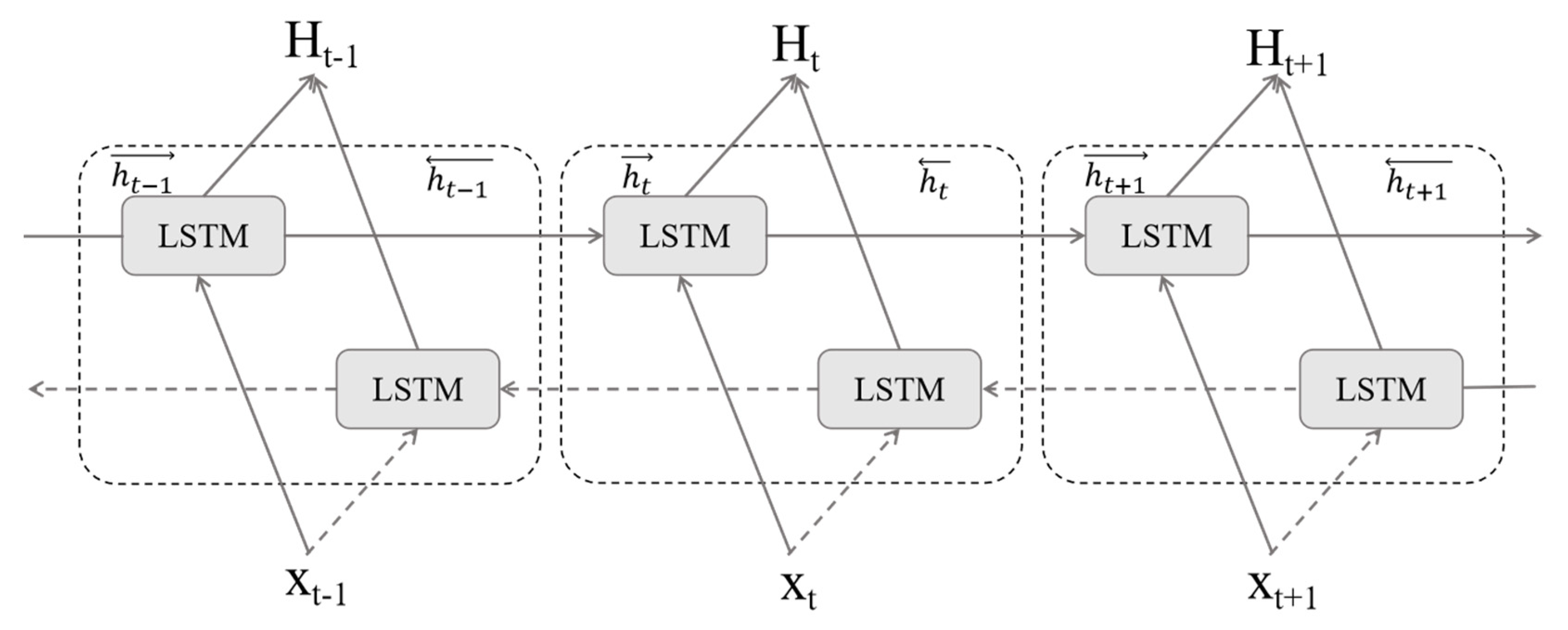

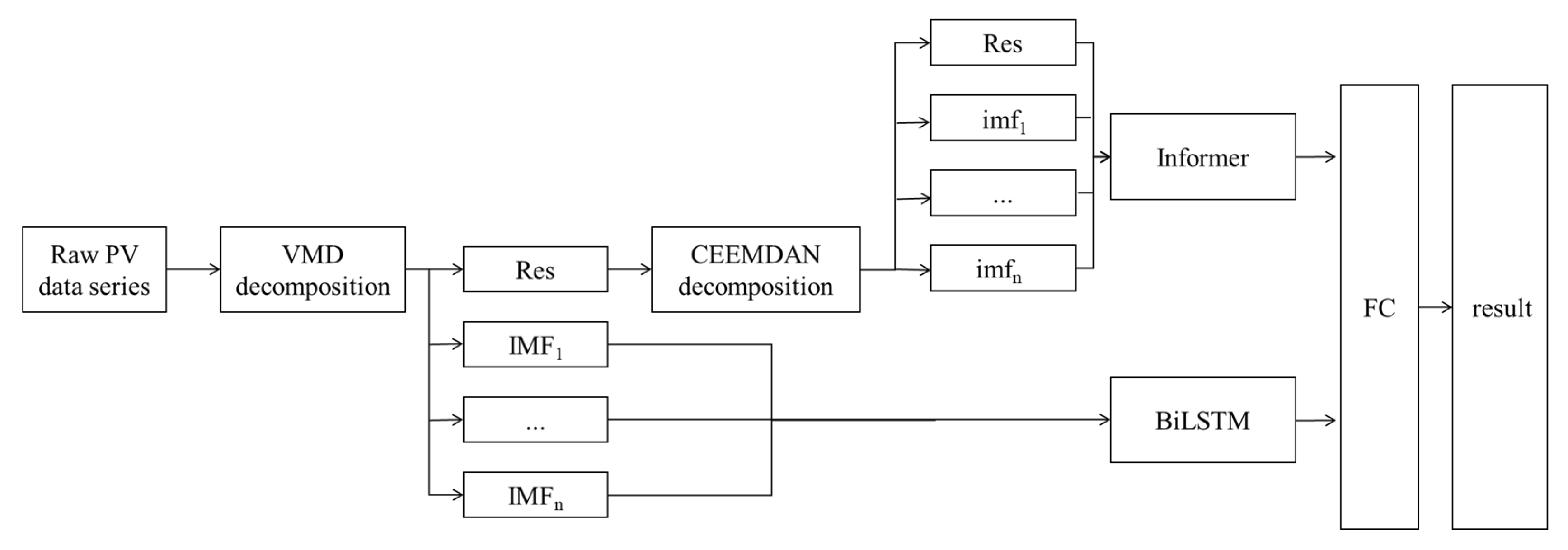
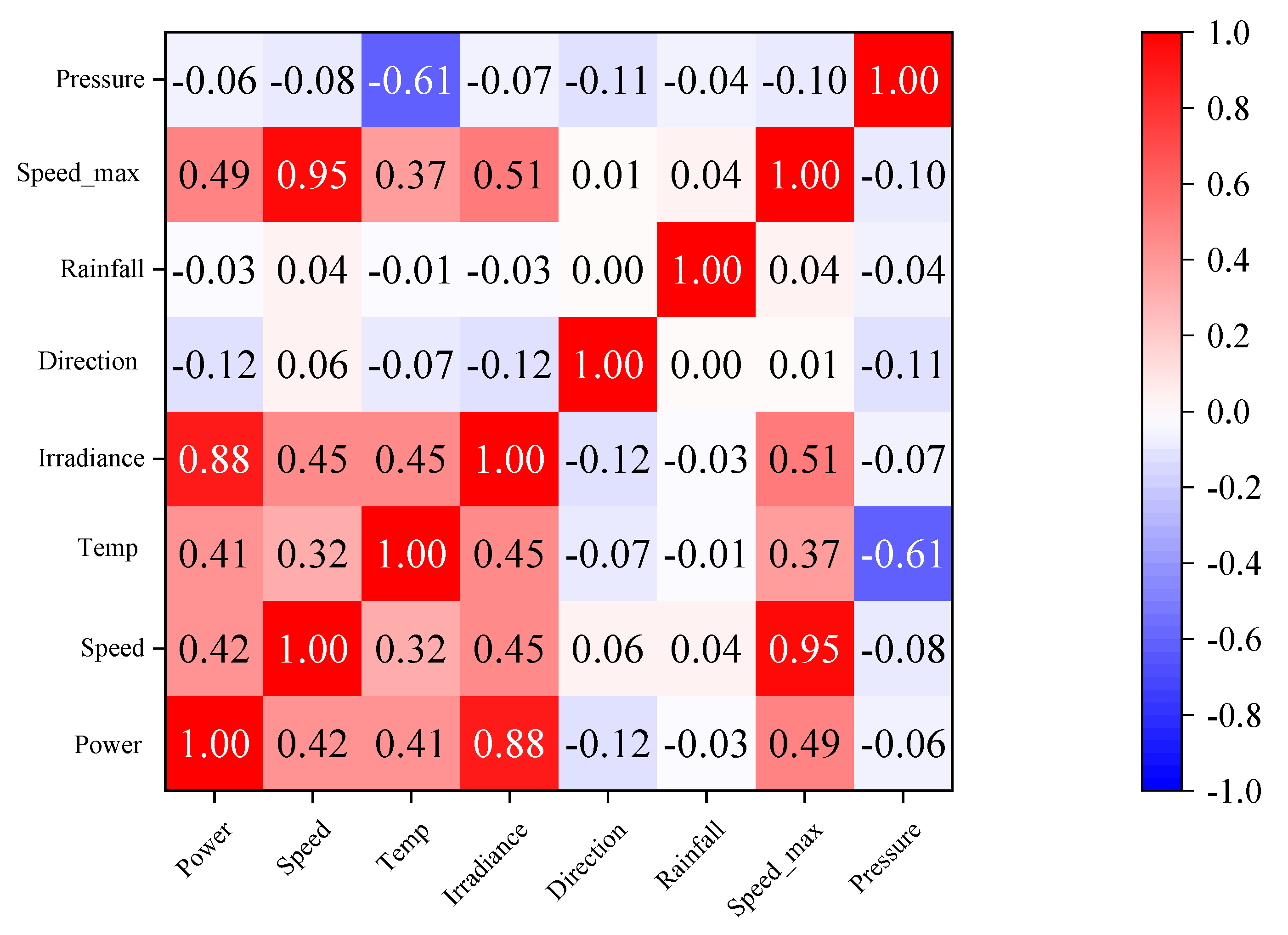

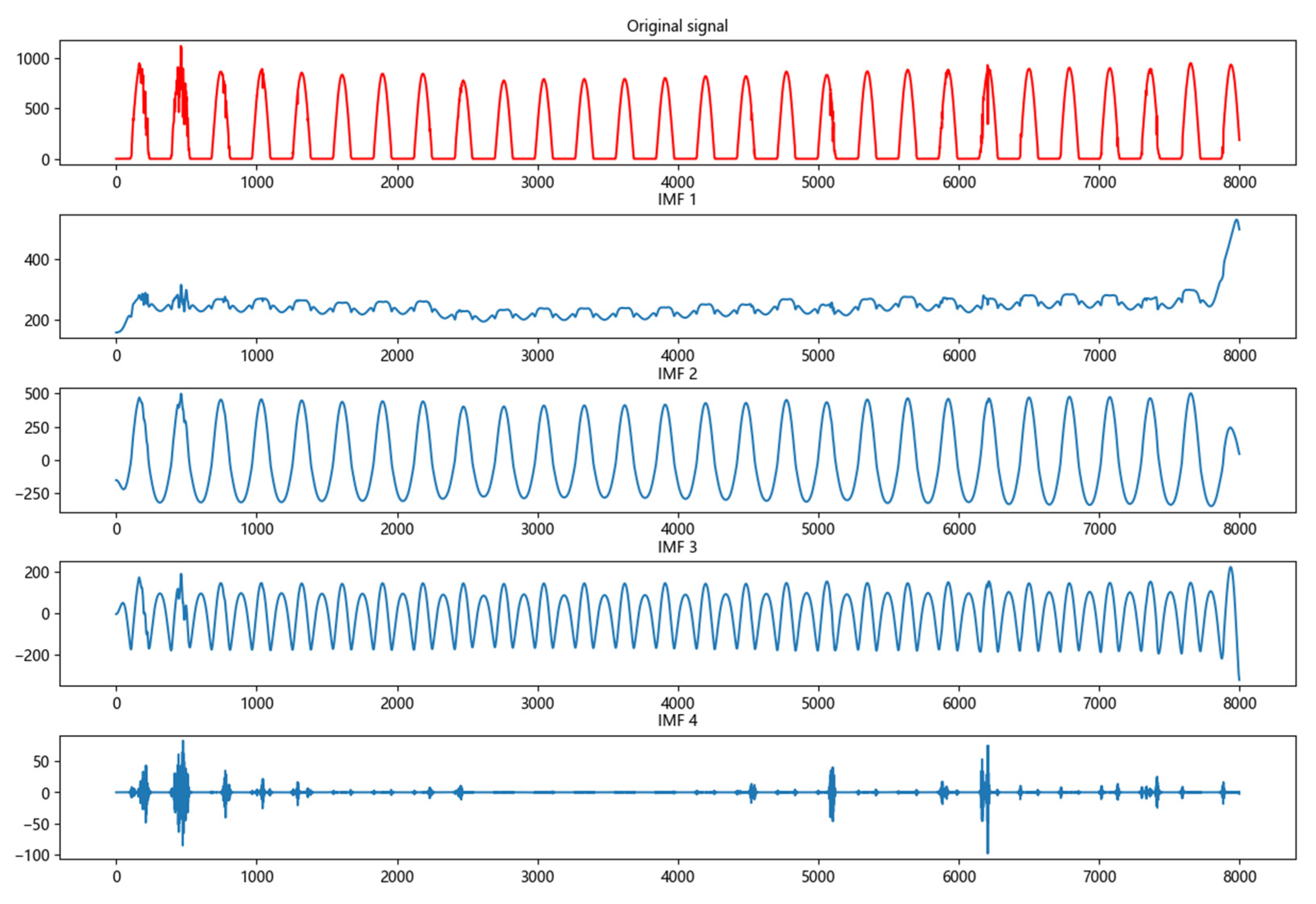

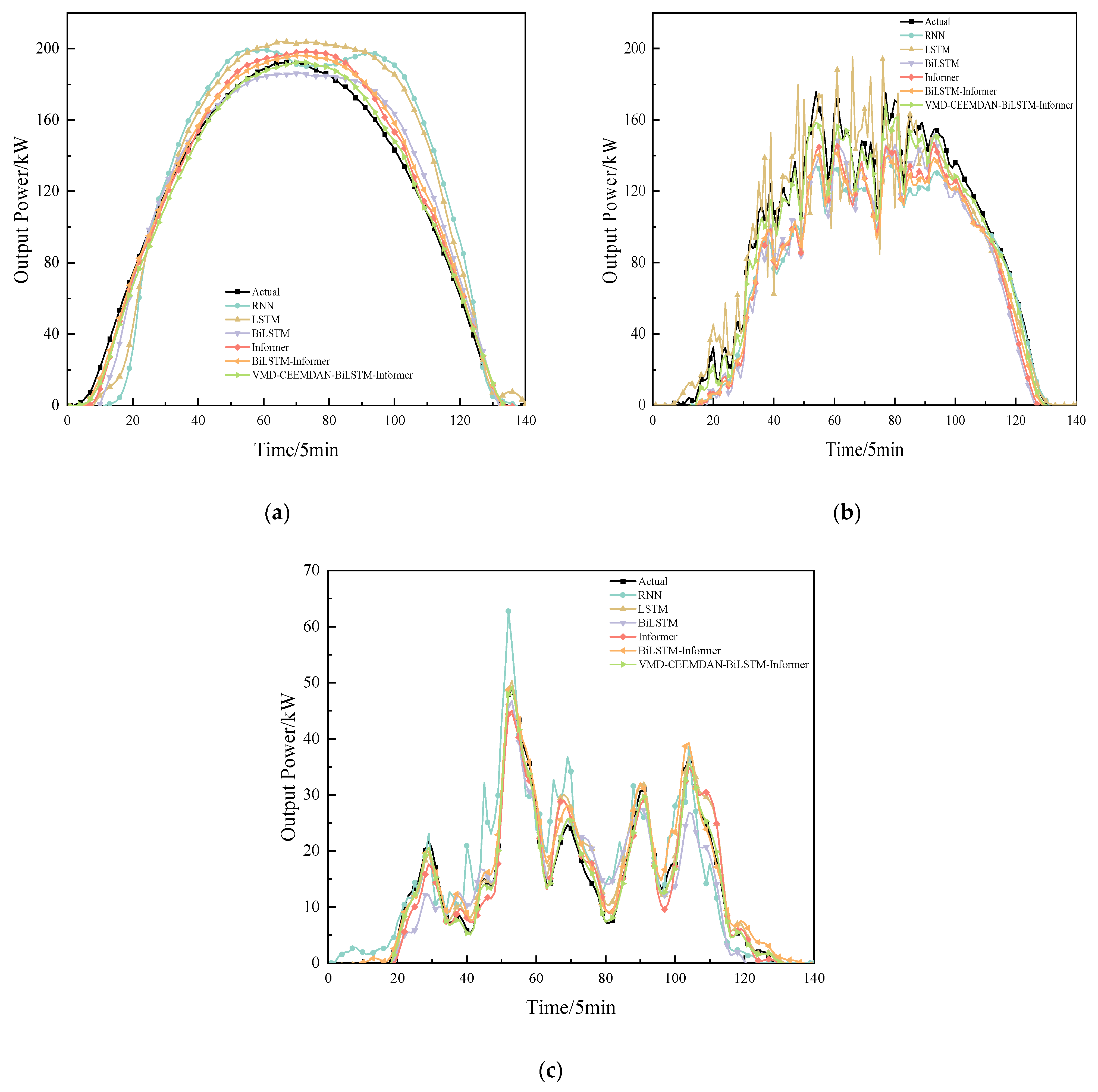
| Seasonal Type | Decomposition Methods | MAE | RMSE | R2 |
|---|---|---|---|---|
| Sunny day | VMD | 0.212 | 0.258 | 0.9586 |
| CEEMDAN | 0.175 | 0.230 | 0.9687 | |
| Secondary decomposition | 0.084 | 0.108 | 0.989 | |
| Cloudy day | VMD | 0.217 | 0.282 | 0.921 |
| CEEMDAN | 0.218 | 0.277 | 0.934 | |
| Secondary decomposition | 0.084 | 0.150 | 0.979 | |
| Rainy day | VMD | 0.275 | 0.372 | 0.856 |
| CEEMDAN | 0.264 | 0.361 | 0.879 | |
| Secondary decomposition | 0.130 | 0.208 | 0.966 |
| Seasonal Type | Model | RMSE | MAE | R2 |
|---|---|---|---|---|
| Sunny day | RNN | 0.3339 | 0.2067 | 0.8975 |
| LSTM | 0.2595 | 0.1781 | 0.9255 | |
| BiLSTM | 0.2004 | 0.1262 | 0.9555 | |
| Informer | 0.1870 | 0.1201 | 0.9613 | |
| BiLSTM–Informer | 0.1161 | 0.0984 | 0.9865 | |
| VMD–CEEMDAN–BiLSTM–Informer | 0.1082 | 0.0842 | 0.9894 | |
| Cloudy day | RNN | 0.2903 | 0.1930 | 0.9164 |
| LSTM | 0.2729 | 0.1986 | 0.9261 | |
| BiLSTM | 0.2628 | 0.2029 | 0.9315 | |
| Informer | 0.1914 | 0.1036 | 0.9636 | |
| BiLSTM–Informer | 0.1688 | 0.1027 | 0.9717 | |
| VMD–CEEMDAN–BiLSTM–Informer | 0.1504 | 0.0849 | 0.9794 | |
| Rainy day | RNN | 0.4017 | 0.2585 | 0.8412 |
| LSTM | 0.3689 | 0.2186 | 0.8754 | |
| BiLSTM | 0.3407 | 0.1874 | 0.9038 | |
| Informer | 0.3013 | 0.1654 | 0.9247 | |
| BiLSTM–Informer | 0.2260 | 0.1480 | 0.9606 | |
| VMD–CEEMDAN–BiLSTM–Informer | 0.2085 | 0.1309 | 0.9664 |
Disclaimer/Publisher’s Note: The statements, opinions and data contained in all publications are solely those of the individual author(s) and contributor(s) and not of MDPI and/or the editor(s). MDPI and/or the editor(s) disclaim responsibility for any injury to people or property resulting from any ideas, methods, instructions or products referred to in the content. |
© 2025 by the authors. Licensee MDPI, Basel, Switzerland. This article is an open access article distributed under the terms and conditions of the Creative Commons Attribution (CC BY) license (https://creativecommons.org/licenses/by/4.0/).
Share and Cite
Zhang, R.; Xu, Z.; Liu, S.; Fu, K.; Zhang, J. Prediction of Ultra-Short-Term Photovoltaic Power Using BiLSTM–Informer Based on Secondary Decomposition. Energies 2025, 18, 1485. https://doi.org/10.3390/en18061485
Zhang R, Xu Z, Liu S, Fu K, Zhang J. Prediction of Ultra-Short-Term Photovoltaic Power Using BiLSTM–Informer Based on Secondary Decomposition. Energies. 2025; 18(6):1485. https://doi.org/10.3390/en18061485
Chicago/Turabian StyleZhang, Ruoqi, Zishuo Xu, Shuangquan Liu, Kaixiang Fu, and Jie Zhang. 2025. "Prediction of Ultra-Short-Term Photovoltaic Power Using BiLSTM–Informer Based on Secondary Decomposition" Energies 18, no. 6: 1485. https://doi.org/10.3390/en18061485
APA StyleZhang, R., Xu, Z., Liu, S., Fu, K., & Zhang, J. (2025). Prediction of Ultra-Short-Term Photovoltaic Power Using BiLSTM–Informer Based on Secondary Decomposition. Energies, 18(6), 1485. https://doi.org/10.3390/en18061485







